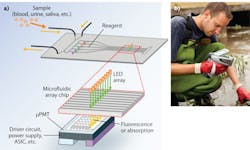PHOTOMULTIPLIER TUBES: μPMT is key to high-performance portable devices
KENGO WATASE
Photosensing technology is widely used in medical, environmental measurement, security, and other applications. But many higher-performance photosensing instruments rely on photomultiplier tubes (PMTs), are bulky, and are therefore found predominantly in large hospitals, inspection centers, and laboratories.
Recently, there has been much interest in reducing the size of these instruments, allowing their use at other sites. To support this trend, a new photodetector called the micro-PMT (μPMT) matches the characteristics of conventional PMTs but is much smaller and lighter.
Operating principle
The μPMT's operating principle is the same as conventional PMTs, which are versatile devices providing ultrafast response and extremely high sensitivity sufficient to measure single photons (see Fig. 1). When light enters the μPMT's photocathode, the light signal is changed into photoelectrons, which are then emitted into vacuum. The μPMT is supplied with about 900 V between the photocathode and anode to create an electric field. The electric field accelerates and moves the photoelectrons to the first dynode.
When the accelerated photoelectrons hit the surface of the first dynode (a secondary emissive surface), the dynode emits secondary electrons. This secondary electron emission process is repeated many times up to the last dynode, resulting in a final gain of more than one million. The multiplied electrons are collected at the anode to produce an output signal.
Structure and features
By fusing our long-established PMT manufacturing, electron trajectory simulation, microelectromechanical systems (MEMS), and vacuum-tube design technologies, we developed the μPMT vacuum detector, which is compact and has the same operating principle as conventional PMTs. The μPMT's size is 13 × 10 × 2 mm, and its weight is about 0.6 g. The cubic volume is about 1/7 and the weight 1/9 of a small conventional PMT.
How can such a small PMT be made? When conventional PMTs are produced, almost all the processes require manual labor. Thus, there are limitations to miniaturization and mass production. In contrast, the μPMT structure is simple: It is composed of a silicon substrate sandwiched between two glass plates and eliminates as much of the manual process as possible.
The μPMT retains a PMT's key features—such as high sensitivity, low noise, high speed, and low temperature dependence—but also has features that conventional PMTs do not offer, such as small size, light weight, rugged structure, and easy mass production. In addition, the μPMT's design can be customized easily due to its manufacturing process; the main body and dynode structure of the μPMT are fabricated on a silicon wafer. Making a customized μPMT only requires creating a photomask with a simple structure. Technically, it is possible to fabricate μPMTs of different shapes on one wafer.
Thus, the μPMT keeps the benefits of conventional PMTs but overcomes the disadvantages of conventional PMTs resulting from the structure and manufacturing process. As a result, numerous high-performance portable devices based on the μPMT are being developed.
Point-of-care testing
Point-of-care testing (POCT), an emerging application area, determines a patient's condition by using a high-performance portable device or test kit at the patient's location. The most important considerations to developing such portable equipment are very compact size and test results similar to those from high-performance instruments used in large hospitals and laboratories.
As noted previously, the μPMT has the same characteristics as conventional PMTs, which are integrated into high-performance instruments used in large hospitals, laboratories, government institutions, and universities. Therefore, compact instruments that integrate the μPMT provide the same test results as the large instruments.
If we successfully develop such POCT devices and deploy them in small hospitals, doctor's offices, and ambulances, then we do not need to go to laboratories or large hospitals to get laboratory tests such as blood tests—and we can know the results quickly. In addition, if people have the analyzer at home and the test results are sent to the hospital automatically, then it is possible to detect diseases early and immediately treat the patient. Such portable devices can be one solution to solving the problems of escalating healthcare costs that face an aging population in many advanced countries, as well as reaching patients that are not usually treated in developing countries.
Biochemical analysis has advanced to a practical stage with the development of micro-total analysis systems (μTAS) using microfluidics. The μTAS uses a chip that consists of fluidic channels and reagent chambers, and analyzes a minuscule amount of sample (for example, blood, urine, and DNA) as the sample flows through the chip and reacts with reagents. Attaching a μPMT directly on the chip reduces the instrument size and results in quantitative measurements of weak light (chemiluminescence, fluorescence, etc.) from a small amount of sample (see Fig. 2).
Environmental monitoring
Environmental monitoring involves measuring rain water, river water, soil water, discharged water from manufacturing plants and houses, effluent gas from vehicles and manufacturing plants, incinerated gas, and powder dust from volcanoes. Environmental measurements analyze a mix of materials in a sample and determine each material's quantity. Analyzers for water quality (antibiotics, adenosine triphosphate, Bacillus coli, salmonella, etc.) and air pollution (sulfur oxides, nitrous oxides, etc.) are usually very large and expensive, but recently mobile versions have been released. To make a portable environmental monitoring system, a compact detector with high signal-to-noise ratio is necessary, and the μPMT meets these requirements.
The μPMT can be used in several application areas such as medical to develop high-performance portable devices. We expect that the μPMT will contribute to creating a healthier and safer world.
ACKNOWLEDGMENT
Micro-PMT (μPMT) is a trademark of Hamamatsu Photonics K.K.
Kengo Watase is a PMT engineer at Hamamatsu Corp., Bridgewater, NJ; e-mail: [email protected]; www.hamamatsu.com.

